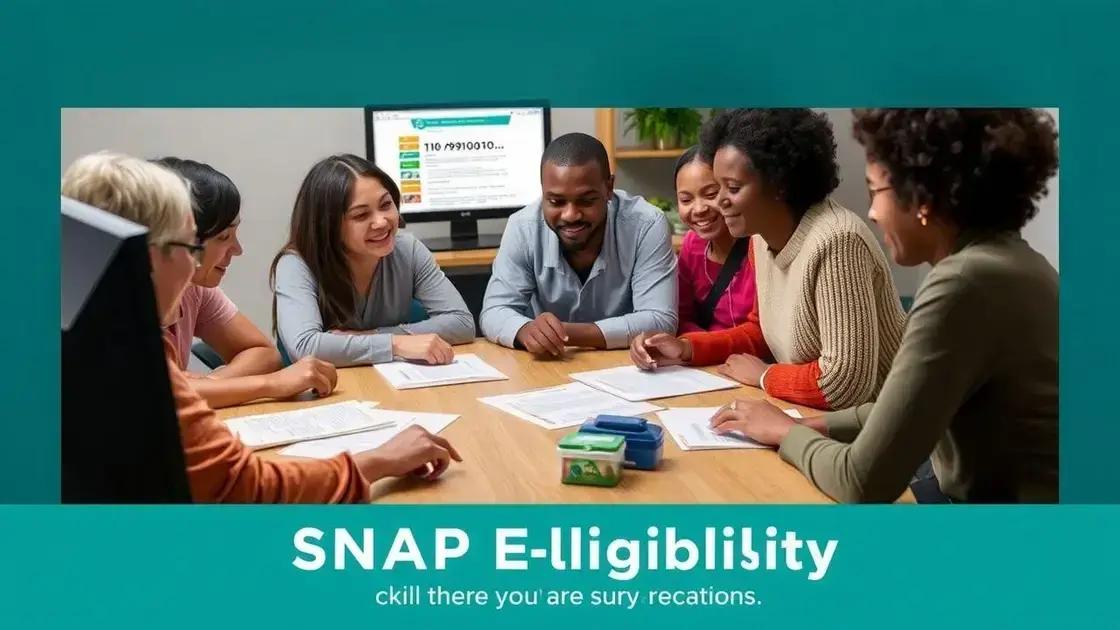Snap eligibility after unemployment: find out your options

SNAP eligibility after unemployment allows individuals to receive food assistance by meeting specific income requirements, and applicants must provide documentation of their household and financial situation.
SNAP eligibility after unemployment can be a lifesaver for many individuals and families facing financial hardships. Have you wondered how job loss affects your food assistance options? Let’s dive into the details and uncover what you need to know.
Understanding SNAP benefits and eligibility
Understanding SNAP benefits and eligibility is essential for anyone affected by job loss or financial difficulties. SNAP, which stands for the Supplemental Nutrition Assistance Program, helps individuals and families purchase food.
To qualify for SNAP, you must meet certain eligibility requirements, including income limits. These limits vary by household size, so it’s important to check the specific thresholds in your state. Additionally, factors like citizenship and work registration can affect your eligibility.
Who qualifies for SNAP?
Generally, you may be eligible for SNAP if:
- Your household income is below a specified level.
- You have a Social Security number.
- All members of your household are either U.S. citizens or legal non-citizens.
Once you apply for SNAP, the local office will review your application to determine if you meet the eligibility requirements. They consider all sources of income and family size to assess whether you qualify for benefits.
How does unemployment impact eligibility?
If you lose your job, your total income decreases, which may help you meet the SNAP eligibility criteria. It’s crucial to apply or reevaluate your eligibility soon after becoming unemployed. Many people do not realize that they can qualify for SNAP while searching for a new job.
In most states, the application process for SNAP can be completed online or in person. Be prepared to provide details about your financial situation. For instance, documentation like pay stubs or bank statements may be required.
In summary, knowing your qualifications and the application process can empower you to secure vital SNAP benefits during challenging times.
The impact of unemployment on SNAP

The impact of unemployment on SNAP benefits is significant, especially for those trying to manage their finances during difficult times. When someone loses their job, it usually leads to a drop in income, making it more likely for them to qualify for SNAP assistance.
Many individuals who are unemployed may not realize they can apply for SNAP. It’s essential to understand how a change in employment status affects eligibility. Once you experience a job loss, it’s a good idea to re-evaluate your financial situation and consider applying for benefits as soon as possible.
How does unemployment affect eligibility?
Unemployment can change the way your household qualifies for SNAP. Here’s how:
- The decrease in income can help you meet the income limits set by your state.
- Employment status may allow flexibility in qualifying for expedited services if you’re facing immediate food insecurity.
- You can often qualify based on your household size, so include everyone who lives with you when applying.
Receiving benefits during unemployment can provide crucial support, allowing you to focus on finding a new job without the added stress of food insecurity. Moreover, many people might be surprised to learn that those receiving unemployment benefits are still eligible for SNAP.
Steps to apply for SNAP during unemployment
If you’ve lost your job and think you might qualify, follow these steps:
- Gather necessary documents, such as identification, income statements, and details about your household.
- Visit your state’s SNAP website to find information on how to apply online or in person.
- Application processing can take time, so apply early to avoid any gaps in assistance.
Understanding the impact of unemployment on SNAP benefits can empower individuals to seek assistance that can help them during tough times. Knowing these details can facilitate a smoother application process and bring much-needed relief.
How to apply for SNAP after job loss
Applying for SNAP after job loss can be a crucial step in ensuring food security during challenging times. The process might seem overwhelming, but understanding the steps will make it easier.
First, gather all necessary documents such as identification, proof of your job loss, and information on your household income. This information is essential for the application, as it helps determine your eligibility. Knowing what to include can speed up the process of receiving assistance.
Steps to apply for SNAP
The application process can vary slightly from state to state, but generally follows these steps:
- Visit the official SNAP website for your state.
- Fill out the online application or download the form to submit by mail.
- Provide necessary documents regarding your household income and expenses.
Once you submit your application, your local office will review it and may contact you for additional information. It’s important to respond promptly to any requests to prevent delays. Many states offer expedited services for those who need immediate assistance, especially if you are facing homelessness or other urgent situations.
What to expect after applying
After your application is submitted, you will receive a notice regarding your eligibility. If approved, you will receive benefits on an EBT card that can be used at grocery stores. Understanding the timeline can help you plan your finances better during this waiting period.
Staying proactive and informed about how to apply for SNAP after job loss will empower you to seek the assistance you need during a difficult time. Remember, don’t hesitate to ask for help if you have questions during the process.
Common questions about SNAP eligibility

Many people have common questions about SNAP eligibility. Understanding these questions can help clarify the application process and financial assistance available.
One frequently asked question relates to income limits. To qualify for SNAP, your household income must fall below specific thresholds. These limits vary based on household size and are updated regularly, so it is important to check the most current information.
Who is considered a household?
A household can include anyone who lives together and shares meals. This may be family members or roommates. All income within the household is considered when applying. Here are key points regarding household structure:
- Adults who buy food together are part of the same household.
- Children may be included even if they do not contribute to the income.
- Cohabitating roommates may qualify as separate households if they do not share food.
Another common question is whether individuals receiving unemployment benefits can qualify for SNAP. Yes, receiving unemployment does not disqualify you from applying, and it may even help you meet eligibility requirements depending on your total income.
How often do you need to reapply?
The need to reapply for SNAP eligibility depends on your state’s guidelines. Most states require you to reapply every 6 to 12 months. Here’s what you should consider:
- Keep track of your renewal date to avoid lapses in benefits.
- Report any changes in income or household size as they occur.
- Timely reapplications will help maintain your assistance without interruption.
By addressing these common questions, individuals can better understand their rights and resources for obtaining SNAP benefits. Empowering yourself with knowledge on this topic can alleviate some of the stress that comes with applying for assistance.
Understanding SNAP eligibility and the application process is essential for anyone facing financial difficulties, especially after job loss. By knowing the requirements and common questions, you can navigate the system more easily. Remember to gather all necessary documents, check state-specific guidelines, and don’t hesitate to ask for assistance if needed. Knowledge is empowering, and by taking the steps outlined, you can secure the help you need to support yourself and your family during tough times.
FAQ – Common Questions about SNAP Eligibility
What are the income limits for SNAP eligibility?
Income limits for SNAP vary by household size and are updated regularly. Check your state’s SNAP website for the most current thresholds.
Can I apply for SNAP if I’m currently receiving unemployment benefits?
Yes, receiving unemployment benefits does not disqualify you from applying for SNAP. In fact, it may help you meet eligibility requirements.
How often do I need to reapply for SNAP?
Reapplication for SNAP is usually required every 6 to 12 months, depending on your state’s guidelines.
What documents do I need to apply for SNAP?
You will need documents such as identification, proof of income, and information about your household size to complete your SNAP application.






